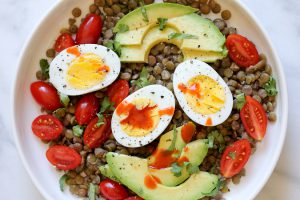 Difference Between Complete and Incomplete Proteins
Difference Between Complete and Incomplete Proteins
Until about 15 years ago when I began seriously getting into the health and fitness industry, I thought protein is protein. And to be quite honest, preferring carbs, several days of the week I hardly ate any protein at all.
However, protein is very important to our bodies. Our bodies use protein to build and repair muscle tissue.
Now that I am a pescetarian, it’s even more important to pay close attention to the differences between complete and incomplete proteins to make sure I am getting enough complete protein in my diet. Vegetarians and vegans, in particular, need to know the difference between complete and incomplete protein and how to combine protein sources to make a complete protein. However, everyone should know the difference between complete and incomplete proteins to be able to make good nutritional choices.
Difference Between Complete and Incomplete Proteins
Protein is made up of amino acids. Amino acids are organic compounds that combine to form protein. There are 20 different amino acids in the body divided into two main types: essential amino acids and non-essential amino acids. Our bodies make some of the amino acids but not others. If the body can’t make a particular amino acid, it is called an essential amino acid–it’s essential to get it through your diet. There are 9 essential amino acids that we need to get from the food we eat: histidine, isoleucine, leucine, lysine, methionine, phenylalanine, threonine, tryptophan, and valine.
Complete proteins contain all 9 of the essential amino acids. Complete proteins are generally animal proteins, which include meat, poultry, fish, dairy and eggs. Incomplete proteins lack one or more of the essential amino acids. Incomplete proteins are generally plant-based and include beans and grains. Two exceptions are soy and quinoa, which are complete proteins. A complete protein gives our bodies all of the amino acids they are unable to produce.
Since our bodies can’t store amino acids, they need a fresh supply every day to build new proteins from these amino acids. Complete and incomplete proteins both play important roles in this process.
Proteins: Complete and Incomplete–We need both types
If eating complete proteins ensures that we get all the amino acids we need, why bother with incomplete proteins? Although incomplete proteins lack one or more of the essential amino acids, each incomplete protein has different characteristics and a different nutritional profile. Each of them lacks different amino acids, but provide others. If your diet is balanced and you eat incomplete proteins from a wide variety of sources, your body will likely still get all of the essential amino acids without needing complete proteins.
Making a Complete Protein
When you combine two incomplete proteins, you create a complete protein.
For example, when you combine beans, lentils or peanuts with grains like whole wheat and brown rice a complete protein is formed.
Do two incomplete proteins need to be eaten at the same time to make a complete protein? It has been thought that you have to combine two complementary protein sources at the same time (in the same meal) to make a complete protein. However, some newer research suggests that this combination doesn’t necessarily have to be all in the same meal– just within a 24 hour period. Personally, I try to combine protein sources in the same meal most of the time.
Difference Between Complete and Incomplete Proteins
Good Sources of Complete Protein:
- Chicken
- Turkey
- Steak
- Pork
- Eggs
- Milk
- Cheese
- Yogurt
- Fish
- Seafood
- Quinoa
- Seitan
- Soybeans
- Protein Enriched Pasta
While the above lists complete proteins, not all protein sources are created equal. Some sources may be healthier than others and some types of a particular protein may be healthier than others from the same source. For example, fish is generally healthier and has more protein than cheese. Pork loin has much less fat than bacon.
Complete Protein Combinations
- Brown rice with black beans
- Peanut butter with whole grain bread
- Lentil soup with brown rice
- Bean burrito with whole grain tortilla
- Hummus with whole wheat pita
These complete protein combinations are not created equal either. One serving of hummus, for example, may only provide 2 or 3 grams of protein, with the whole wheat pita contributing only another 5 grams. One serving of brown rice and beans, on the other hand, has 12 grams of combined protein.
- Almond milk
- Rice milk
Coconut milk
- Nuts
- Seeds
- Avocados
As a health and fitness professional, I have become aware of the fact that many people have the misconception that milk alternatives, such as almond milk and rice milk are nutritional substitutions for milk. These milk alternatives are called “alternatives” because they can be generally used the same way you would use milk–on cereal, to drink… However, while milk has 8 grams of complete protein, these alternatives have about 1 gram (or less) of incomplete protein.
Many people also incorrectly believe that nuts and seeds are a good source of protein. While they do have more protein than many other foods, nutritionally speaking, they are considered fats. Nuts and seeds do contain healthy fats; however, 1 oz. of hulled sunflower seeds, for example, has 14 grams of fat and only about 5 grams of incomplete protein.
I have also learned that for some reason, it has become a common belief that avocados are high in protein. As with nuts and seeds, avocados are a source of healthy fats, but ½ medium avocado contains 10 grams of fat and just 1 gram of incomplete protein.
In Summary
The difference between complete and incomplete proteins pertains to amino acids. Complete proteins contain all the essential amino acids our bodies need. Complete proteins are generally animal proteins. Incomplete proteins lack one or more of the essential amino acids and are generally plant-based. Incomplete proteins can be combined to form complete proteins.
Your Comments Are Welcome.



Wonderful, I have been eating peanut butter for so long and I think it’s my first source of protein every day since I just don’t combine it with bread but I also eat it, Also since I love cooking porridge I add some and it comes out so well. Your article has given me more sources of protein that can be eaten on a day to day servings. thank you for helping us healthwise!
Hi Mercy,
Always happy to help. Thanks for leaving your thoughtful comment.
Hi Sandra. Thank you for writing this and giving me a total understanding of Proteins: Complete and Incomplete. I never knew there is such a thing and you have made me aware of the difference. thank you for sharing this
Hi Michael,
I am happy you found this post educational!
This is an important article for people trying to eat healthy foods. I have learned a tremendous amount in my research in my own health niche, but I did not know enough about the difference in complete and incomplete proteins. I really appreciate this very useful information.
I think you should do an article on the difference between healthy and unhealthy fats. That would also be great information for all people.
Thanks again for the great information.
Thanks for taking the time to leave a comment on the Difference Between Complete and Incomplete Proteins, Curtis. I’m always happy to hear that an article is helpful. Thanks for your suggestion too–I will look into that!
Thanks for this comprehensive post, I somehow also thought all proteins were equal… Every day is school day! Unfortunately, because I am exceedingly sensitive to starches, including beans, I can see that I’m probably not getting enough incomplete proteins, if any at all. Are there any good sources of incomplete proteins which would be not be a grain or a bean?
Hi, Isabel
Thanks for your question. That must be very difficult for you being unable to eat grains and beans. So, I’m assuming no legumes either (lentils, peanuts)? Many foods do contain some protein in varying amounts. Nuts and seeds and even veggies have protein. However, due to your dietary restrictions, you may not be able to combine incomplete proteins to make complete protein.
Hi Sandra,
After reading your informative article, it made me realize that I have a balance of both complete and incomplete proteins. I eat everything in moderation keeping the balance.
It was interesting to read how two incomplete proteins create a complete one. It’s nice to know I’m on the right track, thanks!
Thanks for taking the time to comment on the Difference Between Complete and Incomplete protein. I’m happy to hear you are getting both types of protein in your diet.
I had no idea of this “complete” and “incomplete” protein but I think I’ve been more focused on consuming the complete protein. Since you say we need both I’m going to start having incomplete proteins too. I’m a big fan of chicken, cheese and sea food. So this is what you call complete proteins? So what foods would be incomplete protein? Sorry I’m new to all of this and want to learn more. Cheers for the help
Thanks for your comments and question, Brandon. Yes, complete proteins include animal products: dairy, eggs, fish, chicken… Incomplete proteins are foods that do not have all the essential amino acids, but are still a source of protein–but not complete on their own. They need to be combined with another incomplete protein of another source to make a complete protein. Beans, grains, peanuts are examples of incomplete protein. You can make a complete protein by having a peanut butter sandwich or mexican rice and beans. example.